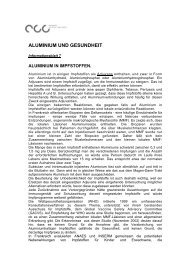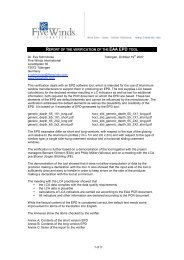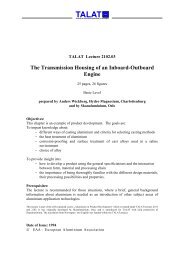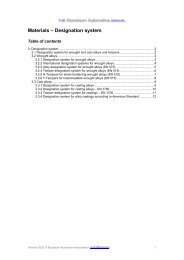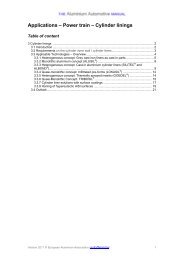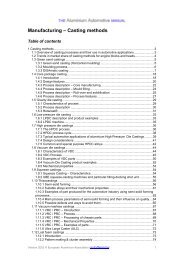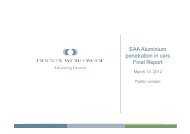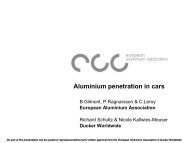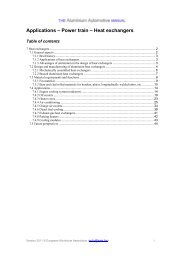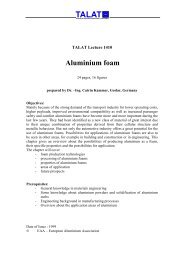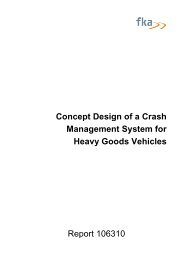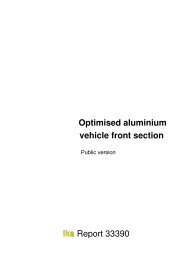aluminium in commercial vehicles - European Aluminium Association
aluminium in commercial vehicles - European Aluminium Association
aluminium in commercial vehicles - European Aluminium Association
Create successful ePaper yourself
Turn your PDF publications into a flip-book with our unique Google optimized e-Paper software.
EUROPEAN ALUMINIUM ASSOCIATION ALUMINIUM IN COMMERCIAL VEHICLES CHAPTER VI 65<br />
Class 1 Class 2 Class 3 Class 4<br />
Cross-sections that can<br />
form a plastic h<strong>in</strong>ge with<br />
the rotation capacity<br />
required for plastic analy-<br />
sis without reduction of<br />
the resistance.<br />
The resistance may be<br />
calculated on the basis<br />
of plastic behaviour tak<strong>in</strong>g<br />
the material harden<strong>in</strong>g<br />
effect <strong>in</strong>to account.<br />
Rules are given <strong>in</strong> EN<br />
1999-1-1. Annex F.<br />
EN 1999-1-1, 6.1.4 gives rules<br />
how to classify any cross-section.<br />
A β value (i.e. width to thickness<br />
ratio) is calculated as:<br />
β = η . b<br />
t<br />
where:<br />
b = the width of a cross-section<br />
part<br />
7.2. Load bear<strong>in</strong>g resistance<br />
The load bear<strong>in</strong>g resistance shall<br />
always be higher than the factored<br />
load effects.<br />
Cross-section that can<br />
develop their plastic<br />
moment resistance, but<br />
have limited rotation<br />
capacity.<br />
The resistance may be<br />
calculated on the basis<br />
of perfectly plastic<br />
behaviour for the material<br />
us<strong>in</strong>g the conventional<br />
elastic limit as the limit<br />
value. Rules are given <strong>in</strong><br />
EN 1999-1-1. Annex F.<br />
TABLE VI.2<br />
Cross-section where the<br />
calculated stress <strong>in</strong> the<br />
extreme fibre of the <strong>alum<strong>in</strong>ium</strong><br />
member can<br />
reach its proof strength.<br />
The resistance is calculated<br />
on the basis of<br />
elastic design.<br />
t = the correspond<strong>in</strong>g thickness<br />
η = a value depend<strong>in</strong>g on the<br />
stress situation and if the part is<br />
an outstand or an <strong>in</strong>ternal crosssection<br />
part<br />
Limits are given for the β value<br />
for the different classes and for<br />
welded or unwelded parts and<br />
for outstand or <strong>in</strong>ternal parts.<br />
Most <strong>alum<strong>in</strong>ium</strong> structures <strong>in</strong><br />
EN 1999-1-1 gives rules for calculat<strong>in</strong>g<br />
the load bear<strong>in</strong>g resistances<br />
for different k<strong>in</strong>ds of members<br />
exposed by different load<br />
effects. In the Table VI.3, some of<br />
Cross-section that will get<br />
local buckl<strong>in</strong>g before<br />
atta<strong>in</strong>ment of proof stress<br />
<strong>in</strong> one or more parts of<br />
the cross-section.<br />
The resistance is calculated<br />
on basis of an effective<br />
cross-section. Rules<br />
for calculat<strong>in</strong>g the effective<br />
cross-section are<br />
given <strong>in</strong> EN 1999-1-1,<br />
6.1.5<br />
<strong>commercial</strong> <strong>vehicles</strong> will be optimised<br />
regard<strong>in</strong>g weight. Cross<br />
section classes 1 and 2 will therefore<br />
seldom be used. Elastic<br />
design <strong>in</strong> cross section class 3 and<br />
4 will be the normal situation.<br />
these rules are listed, and references<br />
are given:



